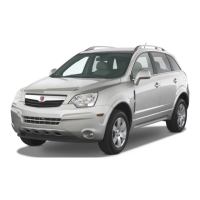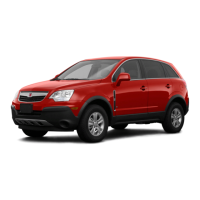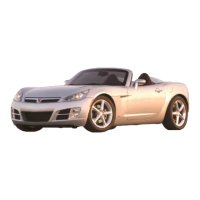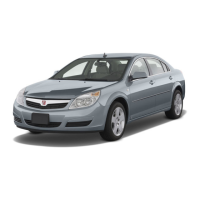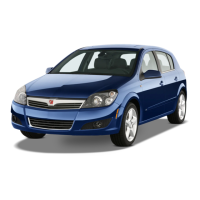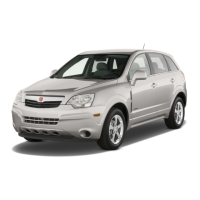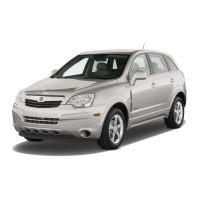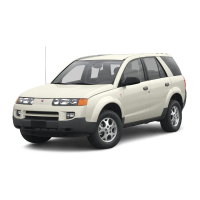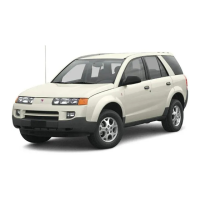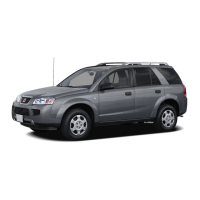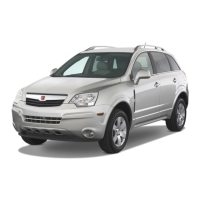
Do you have a question about the Saturn 2008 Vue and is the answer not in the manual?
| Brand | Saturn |
|---|---|
| Model | 2008 Vue |
| Category | Automobile |
| Language | English |
Explains adjustable and active head restraint systems for occupant safety and proper neck injury prevention.
Details manual and power seat adjustments, lumbar support, heating, and reclining features.
Covers split folding rear seat functionality and rear door security lock features.
Discusses proper usage, importance, and types of safety belts for all occupants.
Provides guidance on selecting, installing, and using child restraint systems for various age groups.
Explains airbag types, locations, deployment, and crucial safety precautions.
Outlines procedures for checking the condition of safety belts and airbags for proper function.
Details the function of vehicle keys and safety precautions regarding children and keys.
Explains the operation of the RKE system, including lock, unlock, and panic alarm functions.
Describes the feature to start the engine remotely and its operational guidelines.
Covers door lock operation, delayed locking, automatic locking/unlocking, and security locks.
Explains liftgate operation, including safety precautions and loss of power procedures.
Details power window operation, express-down feature, and window lockout functionality.
Describes the vehicle's theft-deterrent features, including content theft-deterrent alarm.
Covers new vehicle break-in, ignition positions, starting the engine, and transmission operation.
Details manual and automatic dimming rearview mirrors, and outside power mirror adjustments.
Explains OnStar's technologies, services, and how the system operates for safety and convenience.
Describes the system for replacing transmitters and its operation and programming.
Details various storage locations including glove box, console, luggage carrier, and cargo management.
Explains sunroof operation, including express-open, tilt, and sunshade controls.
Identifies and locates the main components of the instrument panel and their functions.
Explains the function of hazard warning flashers for signaling problems.
Describes how to operate the vehicle's horn.
Details how to adjust the steering wheel's tilt and telescopic position.
Explains the operation of turn signals and multifunction controls on the steering column lever.
Describes how to switch between high and low beams and the indicator light.
Details the operation of windshield wipers, including speed and Rainsense™ settings.
Explains the automatic operation of Rainsense™ wipers based on moisture detection.
Describes how to operate the windshield washer and the heated washer fluid system.
Explains the operation of the rear window wiper and washer system.
Details the function and operation of cruise control, including safety precautions.
Provides step-by-step instructions for setting, resuming, and ending cruise control speeds.
Explains the operation of exterior lamps, including parking lamps and headlamps.
Describes the function and conditions for daytime running lamps to enhance visibility.
Explains the automatic operation of headlamps based on ambient light conditions.
Details the operation of fog lamps for improved visibility in adverse weather conditions.
Describes how to adjust the brightness of the instrument panel illumination.
Explains the operation of dome lamp override and on/off functions.
Details the automatic operation of interior lamps upon door opening or remote unlock.
Explains the battery saver feature that automatically turns off lamps after a period.
Describes the location and use of accessory power outlets for electrical equipment.
Explains the operation of the climate control system for heating, cooling, and ventilation.
Details the automatic operation of climate control for temperature and airflow management.
Describes how to access and replace the passenger compartment air filter.
Provides descriptions of various warning lights, gauges, and indicators on the instrument panel.
Explains the layout and function of the instrument cluster for vehicle operation information.
Describes the chime and light system that reminds occupants to buckle safety belts.
Explains the function of the airbag readiness light and potential system malfunctions.
Details the passenger airbag status indicator and its meaning for front passenger airbag enablement.
Explains the charging system warning light and potential causes of battery drain.
Describes the brake system warning light and actions to take if it illuminates.
Explains the ABS warning light and its function during system checks.
Details the SSPS warning light and what to do if it stays on or comes on while driving.
Explains the TCS warning light and its behavior when limiting wheel spin or when TCS is off.
Describes the ESP indicator light and its function during system operation or failure.
Explains the engine coolant temperature warning light and actions for overheating.
Provides information about tire pressures and the Tire Pressure Monitor System.
Explains the check engine light and conditions that may cause it to illuminate.
Describes the oil pressure warning light and its implications for engine lubrication.
Explains the low oil level warning light and the importance of checking oil promptly.
Indicates when service is required for the vehicle, specifically for engine oil.
Provides information regarding the security light and the vehicle's security system.
Indicates when the fog lamps are in use.
Signals a noticeable reduction in vehicle performance, requiring service.
Indicates when the cruise control system is set.
Indicates when the high-beam headlamps are in use.
Indicates a malfunction in the All-Wheel Drive (AWD) system.
Indicates when the windshield washer fluid level is low.
Indicates if the liftgate is not completely closed, warning of potential CO entry.
Indicates when a door is open, requiring a check for proper closure before driving.
Signals a condition that may require vehicle service.
Indicates the amount of fuel remaining in the tank.
Describes the DIC display for vehicle information like odometer and temperature.
Explains the operation of the audio system, including radio, CD, MP3, and navigation features.
Provides instructions for setting the clock time and date for the radio system.
Details various messages displayed by the XM radio system regarding channels and updates.
Discusses the interplay of driver behavior, environment, and vehicle design for safe driving.
Emphasizes buckling up, avoiding speed, abrupt turns, and drunk driving for trip safety.
Covers preparation for inclement weather, night driving, and unfamiliar terrain hazards.
Promotes anticipating unexpected events and maintaining focus on driving.
Highlights the severe dangers of drinking and driving and its effects on driving ability.
Explains how brakes, steering, and accelerator systems help control the vehicle.
Discusses braking action, perception/reaction time, and stopping distances.
Explains how ABS prevents braking skids and how to use it effectively.
Covers emergency braking techniques, including steering and braking simultaneously.
Details the TCS function to limit wheel spin, especially in slippery conditions.
Explains the ESP system that combines ABS, traction, and stability control for directional control.
Describes the automatic operation of the AWD system for enhanced traction.
Covers electric and hydraulic power steering systems and their operation.
Provides a guide for off-road driving, including terrain considerations and safety rules.
Offers tips for safer night driving, including visibility and driver impairment considerations.
Discusses reduced traction on wet roads, hydroplaning, and driving cautiously.
Provides a checklist for vehicle preparation before embarking on a long journey.
Offers tips for driving on steep hills, including gear selection and safety precautions.
Provides tips for safe winter driving, including vehicle preparation and driving on snow or ice.
Offers advice on what to do if stopped by heavy snow, including summoning help.
Explains how to handle stalling on an incline and safety precautions for exiting the vehicle.
Provides guidelines for loading cargo securely and safely for off-road conditions.
Covers essential considerations for towing a trailer or another vehicle.
Explains how trailer tongue weight affects vehicle capacity and towing limits.
Provides rules and considerations for selecting and installing the correct trailer hitch equipment.
Offers advice on handling, braking, and checking equipment when driving with a trailer.
Information on obtaining service and genuine Saturn parts from dealers/retailers.
Discusses how accessories can affect vehicle performance and safety.
Notifies about chemicals in vehicles known to cause cancer or reproductive harm.
Provides safety precautions and requirements for performing DIY vehicle maintenance.
Discusses recommended fuel, octane ratings, and specifications for optimal engine performance.
Details safe fuel filling procedures, pump island instructions, and fire safety precautions.
Covers checks for electric fans and hot engine parts, emphasizing safety during inspections.
Explains how to open the vehicle's hood and secure it properly.
Provides diagrams and identification of components in the engine compartment.
Details how to check, add, and select the correct engine oil for optimal performance.
Explains how to inspect and replace the engine air cleaner/filter for optimal air intake.
Discusses transmission fluid level, checking procedures, and recommended fluid types.
Explains the cooling system, coolant types, and how to add coolant safely.
Details when and how to check power steering fluid levels and system maintenance.
Provides guidance on selecting and adding windshield washer fluid, including safety notes.
Covers brake fluid, wear indicators, pedal travel, and adjustment procedures.
Information on battery maintenance, storage, and safety precautions.
Provides step-by-step instructions for safely jump-starting a vehicle with a dead battery.
Covers lubricant checks for the transfer case and AWD differential.
Explains how to adjust headlamp aim and the conditions for adjustment.
Details procedures for replacing various exterior bulbs, including halogen bulbs.
Provides information on tire maintenance, including checking pressure, wear, and replacement.
Explains the information molded into tire sidewalls, including size, construction, and load ratings.
Defines key tire terminology such as air pressure, aspect ratio, and treadwear.
Details the importance of correct tire pressure and how to check it.
Discusses tire pressure adjustments for high-speed driving and related safety concerns.
Explains the TPMS operation, low pressure warnings, and malfunction indicators.
Recommends regular tire inspection and rotation for uniform wear and vehicle performance.
Provides guidelines for replacing wheels, including safety precautions and correct parts.
Offers tips on what to expect and how to handle a tire blowout or slow leak.
Provides step-by-step instructions for safely changing a flat tire.
Details how to access and remove the spare tire and associated tools.
Offers advice on cleaning interior surfaces, including fabric, vinyl, and plastic.
Provides guidelines for washing the vehicle's exterior to preserve its finish.
Details how to clean aluminum wheels and precautions against damage.
Explains the VIN, engine identification, and service parts identification label.
Covers add-on electrical equipment, fuses, and power options.
Provides an overview of maintenance requirements, intervals, and the schedule's usage.
Details services required based on the Change Engine Oil light and maintenance intervals.
Lists specific services required at various mileage intervals for optimal vehicle performance.
Outlines owner-performed checks and services to ensure safety and dependability.
Lists important underhood checks to perform during each fuel fill.
Recommends monthly checks for tire inflation and tire wear inspection.
Details annual checks for starter switch and transmission shift lock control systems.
Lists recommended fluids and lubricants by name, part number, or specification.
Provides a list of replacement parts with Saturn and ACDelco part numbers.
Illustrates the routing diagrams for engine drive belts for different engine types.
Provides a template for recording scheduled maintenance services and dates.
Outlines the customer satisfaction procedure and contact information for assistance.
Details how to report safety defects to U.S. Government, Canadian Government, and Saturn.
Provides information on how to order service manuals and owner publications.
Explains vehicle data recording by EDRs and privacy considerations.
Discusses the use of the navigation system and storage of trip information.
Explains the use of RFID technology in vehicles for functions like tire pressure monitoring.
